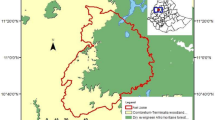Abstract
In 2007 we conducted a field study of almost 6 mo to determine the distribution of Callicebus oenanthe, formerly known as the Andean titi monkey. There previously has been no extensive study on the distribution and status by other fieldworkers. We visited a total of 96 localities within or around the presumed distribution of this rare primate species to determine the distribution of Callicebus oenanthe. We collected additional information on group size and threats to the species. Our expeditions revealed that the species is not endemic to the Alto Mayo Valley, as earlier authors suggested, but that its distribution extends into the Bajo Mayo and Huallaga Central. The study area is heavily deforested, and to date only one area was found where a viable population might live, although further research is needed to confirm this. The species lives in the southern part of its distribution in sympatry with another, undescribed species of Callicebus. We will continue the study to determine more precisely the distribution and conservation status of the Callicebus oenanthe, to determine if conservation measures are necessary for this species. This is the first activity of a long-term project for the conservation of Callicebus oenanthe initiated by La Vallée des Singes Primate park.

Similar content being viewed by others
References
Aldrich, B. C. (2006). A song-based survey of the Andean titi monkey (Callicebus oenanthe) at Tarangue, with notes on its vocalisations. MSc dissertation, Oxford Brookes University.
DeLuycker, A. M. (2006). Preliminary report and conservation status of the Rio Mayo titi monkey, Callicebus oenanthe Thomas, 1924, in the Alto Mayo Valley, Northeastern Peru. Primate Conservation, 21, 33–39. doi:10.1896/0898-6207.21.1.33.
Groves, C. (2001). Primate taxonomy. Washington, DC: Smithsonian Institution Press.
Hershkovitz, P. (1963). A systematic and zoogeographic account of the monkeys of the genus Callicebus (Cebidae) of the Amazonas and Orinoco river basins. Mammalia, 27, 1–79.
Hershkovitz, P. (1990). Titis, New World monkeys of the genus Callicebus (Cebidae, Plathyrrhini): A preliminary taxonomic review. Fieldiana, Zoology. New Series, 55, 1–109.
Hill, W. C. O. (1960). Primates: Comparative anatomy and taxonomy IV. Cebidae Part A. Edinburgh: Edinburgh University Press.
Mark, M. (2003). Some observations on Callicebus oenanthe in the Upper Rio Mayo Valley, Peru. Neotropical Primates, 11, 183–187.
Martinez, J., & Wallace, R. B. (2007). Further notes on the distribution of endemic Bolivian titi monkeys, Callicebus modestus and Callicebus olallae. Neotropical Primates, 14(2), 47–54.
Rowe, N., & Martinez, W. (2003). Callicebus sightings in Bolivia, Peru and Ecuador. Neotropical Primates, 11, 32–35.
Van Roosmalen, M. G. M., Van Roosmalen, T., & Mittermeier, R. A. (2002). A taxonomic review of the titi monkeys, genus Callicebus Thomas, 1903, with the description of two new species, Callicebus bernhardi and Callicebus stephennashi, from Brazilian Amazonia. Neotropical Primates, 10(Suppl.), 1–52.
Vermeer, J., Bóveda-Penalba, A. J., & Rodrigo, F. The description of a new species of Callicebus from Peru. (in preparation)
Acknowledgments
The greater part of this study was initiated and funded by Le Conservatoire pour la Protection des Primates of the primate park La Vallée des Singes of Romagne, and the Friends of Blackpool Zoo. The Twycross Zoo, the Zoological Society of London, Shaldon Wildlife Trust and Primate Conservation, Inc. provided additional indispensable financial support.
We thank Emmanuel Le Grelle, director of La Vallée des Singes, for his support to Le Conservatoire pour la Protection des Primates and for making this study possible. We thank INRENA for authorization (Authorization no.124–2007-INRENA-IFFS-DCB) to conduct this study, and the Dirección de Teledetección y SIG for their help with the maps. We thank Eckhard Heymann (DPZ), who helped us with writing this article.
We also thank Hélène Collongues de Palomino and Carlos Palomino of Ikamaperou. Their moral and logistic support and hospitality made the times that we were not in the field extremely pleasant. We thank Julio César Tello Alvarado, who accompanied us for 3 wk and our driver Paulino Rafael Altamirano; Noelia Venegas Martín, Marcela Castillo Ahuir, and Karen Bendezú Aguilar for their assistance and hard work on the educational part of the project; and Victor Pacheco (Natural History Museum of Lima) and Lizette Bermúdez, Gianmarco Rojas, and Catalina Hermoza (Huachipa Zoo) for their support of the titi project.
Our work would not have been possible without the help and hospitality of the Peruvian people, who were always friendly and happy to respond to our questions.
Author information
Authors and Affiliations
Corresponding author
Rights and permissions
About this article
Cite this article
Bóveda-Penalba, A.J., Vermeer, J., Rodrigo, F. et al. Preliminary Report on the Distribution of Callicebus oenanthe on the Eastern Feet of the Andes. Int J Primatol 30, 467–480 (2009). https://doi.org/10.1007/s10764-009-9353-2
Received:
Accepted:
Published:
Issue Date:
DOI: https://doi.org/10.1007/s10764-009-9353-2




